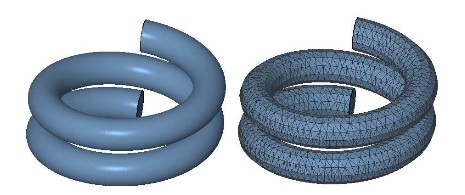STL is the industrial standard for handling triangulated meshes. STL files contain a plain list of three-dimensional corner point coordinates and flat triangles. Triangles, also referred to as faces, are defined by three corner points and have an inside and an outside. Adjacent triangles may use common corner points and share the same edges, which results in a continuous triangle mesh. The generality and simplicity of this concept makes STL files compatible with many applications.

Parametric Surface and Triangulated Representation
However, they do not contain any topological information about the mesh. This causes typical errors when CAD files with different file formats are converted to STL. Netfabb is a specialized software to detect and repair these kinds of damages and create faultless meshes without holes, deformations or intersections.
These meshes can then be converted into slice files ready for additive manufacturing. The STL format aims for a precise approximation of bodies in three-dimensional space. Although other CAD formats have advantages in that respect, a variety of applications need a surface representation consisting of flat triangles. These are:
- Rapid prototyping and additive manufacturing
- Accelerated rendering in multimedia applications
- Solving partial differential equations
- Computer Aided Design (CAD)
However, a simple collection of triangles will not always create a solid body. For a good triangle mesh that can be used for 3D printing, the mesh has to be valid, closed, oriented and should not contain any self-intersections.